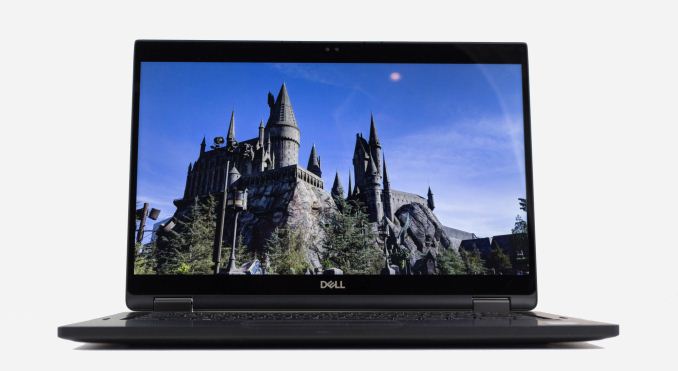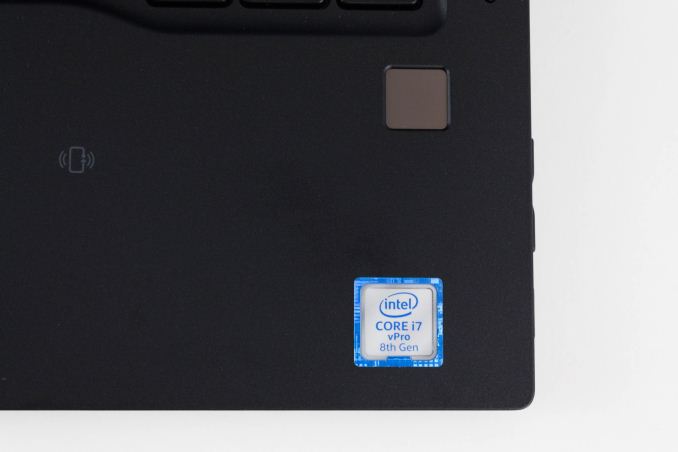The Dell Latitude 13 7390 2-in-1 Review
by Brett Howse on April 12, 2018 8:00 AM EST
Dell’s XPS lineup of consumer laptops are some of the best in the business, and Dell started the thin-bezel trend that has now taken over the industry. But if you’re in the market for a business laptop and the practicality that implies, their Latitude lineup is likely more suited for your needs. To that end, today we’re taking a look at the latest Dell Latitude 13 2-in-1 model, the 7390. This latest business model from Dell features all of the latest features, including 8th generation quad-core CPUs, and the business features you’d expect like vPro, and optional Smart Card support. It even offers cellular connectivity for those that need to work on the go.
And working on the go is really the goal of the Latitude 13 7390. As we’ll see in a bit, it features great battery life, along with a thin and light chassis, but still offers the great performance of the Kaby Lake Refresh CPUs.
| Dell Latitude 7390 2-in-1 | |||||
| Base | Mid | High Model Tested |
|||
| CPU | Core i3-7130U Dual Core w/HyperThreading 2.7 GHz Base Frequency 15W TDP 3 MB Cache |
Core i5-8250U or 8350U Quad-Core w/Hyperthreading 1.6 -3.4 GHz (8250U 1.7-3.6 GHz (8350U) 15 W TDP 6 MB Cache |
Core i7-8650U Quad-Core w/HyperThreading 1.9-4.2 GHz 15W TDP 8 MB Cache |
||
| Memory | 4 GB LPDDR3-1866 | 8 GB LPDDR3-1866 | 16 GB LPDDR3-1866 | ||
| Storage | M.2 SATA 128 - 256 GB 256 - 512 GB NVMe |
M.2 SATA 128 - 256 GB 256 - 1024 GB NVMe As tested: 512 GB NVMe |
|||
| Display | 13.3" 1920x1080 Touch IPS | ||||
| Networking | Qualcomm QCA61x4A 802.11ac Optional Intel Dual Band Wireless-AC 8265 Optional Qualcomm Snapdragon X7 LTE-A Cellular |
||||
| Battery | 42 Whr Prismatic ExpressCharge 60 Whr Polymer ExpressCharge 60 Whr Long Life Cycle Polymer |
||||
| I/O | 2 x USB 3.1 Gen 1 2 x USB Type-C w/Optional TB3 1 x HDMI 1.4 1 x uSIM slot (WWAN only) 1 x microSD Headset Jack |
||||
| Dimensions | "Narrow Bezel Height: 0.46''- 0.70” / 11.75-17.85mm (Front to Back) Standard Bezel Height: 0.51''- 0.75” / 12.92-19.03mm (Front to Back) Width: 12” / 305.1mm Depth 8.26” / 210mm (211mm standard bezel) " |
||||
| Weight | Starting weight: 3.12lb / 1.42kg with WLAN, 45Whr 3-cell Battery, M.2 128GB SSD |
||||
| Starting Price | $1,149 | $1,429 | $1,849 | ||
Dell offers a nice package in the Latitude 7390, with plenty of configuration options to pick out just the right amount of performance. The base model is somewhat lacking though, with just a Core i3-7130U CPU, 4 GB of LPDDR3 RAM, and a 128 GB SSD; so the base price of $1149 is not likely to be where most people would want to configure it. Realistically, you’d want at least the Core i5-8250U, 8 GB of LPDDR3, and 256 GB of storage, so you’re looking closer to $1500 for the package.
As the top end model in the Latitude lineup, the price is a bit more realistic, since Dell offers plenty of options for less if this is out of your budget, but for a premium 2-in-1 business laptop, it’s realistically in the range you’d see other devices.
Dell has been quite good about providing connectivity options with the rise of new formats like USB-C and Thunderbolt 3, and with the Latitude 7390, that’s again the case. Dell has ditched their barrel connector and moved to USB-C charging, and they offer Thunderbolt 3 on both of the USB-C ports. In addition, they have USB-A ports on both sides, as well as micro SD support. This, in addition to Smart Card options and cellular connections, means Dell offers plenty of capabilities to suit almost any need.











28 Comments
View All Comments
coolhardware - Sunday, April 22, 2018 - link
I still use and love the Lenovo TrackPoint (or "nub" as you refer to it). It is not trendy, but it is still very good IMHO.hybrid2d4x4 - Thursday, April 12, 2018 - link
Not trying to be facetious here: what is the use case for having a microSD reader? Many laptops are migrating to offering this where they used to offer regular SD readers, and I'm curious if this is user-driven or OEMs trying to axe a larger component?Personally, I mostly use a laptop while traveling and I use a DSLR, so I find a regular size SD reader useful. But the only device I own that uses microSD is my phone and it's more of a hassle to remove the card and use a reader than just connect the phone via USB. I wouldn't be surprised if something like GoPros used uSD, but is that demographic that large? What else is uSD broadly used for?
PeachNCream - Thursday, April 12, 2018 - link
In my own day-to-day computing, I haven't used a standard sized SD card in quite a while because the only thing I own that can accept standard sized SD cards is my laptop. It's actually a little bit annoying to go dig an adapter out of a desk drawer so I'd rather see laptops fall in line with the other consumer electronics that already have made the transition to microSD. At this point, standard SD seems a bit outdated to me.piroroadkill - Friday, April 13, 2018 - link
This is a redundant comment, because a lot of microSD cards come with a microSD to full size SD adapter. You can just leave the adapter in the slot if it bothers you that much. Other people might actually want the full size slot for their camera SD card.PeachNCream - Friday, April 13, 2018 - link
"...if it bothers you that much."It doesn't bother me that much. That's why I said it was "a little bit annoying" rather than "it bothers me a lot" or "very annoying." It just ends up seeming like you're inflating my concern in order to invalidate my comment about my own usage (which I clearly defined right away as applying to no one else but me) in order to support an opposed viewpoint.
It's fine if you want a full size SD slot. Then again, what's stopping someone from arguing that you can leave the adapter in a camera instead of a laptop? MicroSD write speed is pretty high and competitive with standard sized cards. I used an adapter in the last camera I owned a few years ago because microSD was cheaper for the same capacity and speed when I was buying storage for it.
BurntMyBacon - Friday, April 13, 2018 - link
In my day to day use, I've only really seen heavy use of microSD in phones/tablets. I have to echo the earlier sentiment that it is usually easier to just connect the phone/tablet than to remove the microSD card. A great many cameras, however, use SD. I'm sure there are plenty of devices that make use of microSD, but outside of phones/tablets, I just don't run across them. Also, it is very easy to adapt microSD to SD, but not the other way around. Furthermore, as piroroadkill pointed out, it wouldn't be at all problematic to leave the microSD to SD card adapter in the SD slot if you wanted a more permanent microSD solution.sofie123 - Friday, April 13, 2018 - link
As i have seen the features and the specification of the Dell Latitude 7392 it is quite a great gadget to be owned. The Dell Alienware is also great gadget if you are a game freak.https://www.uaetechnician.com/alienware-support-se...
RErro - Thursday, April 26, 2018 - link
Finally, a review on a business laptop.